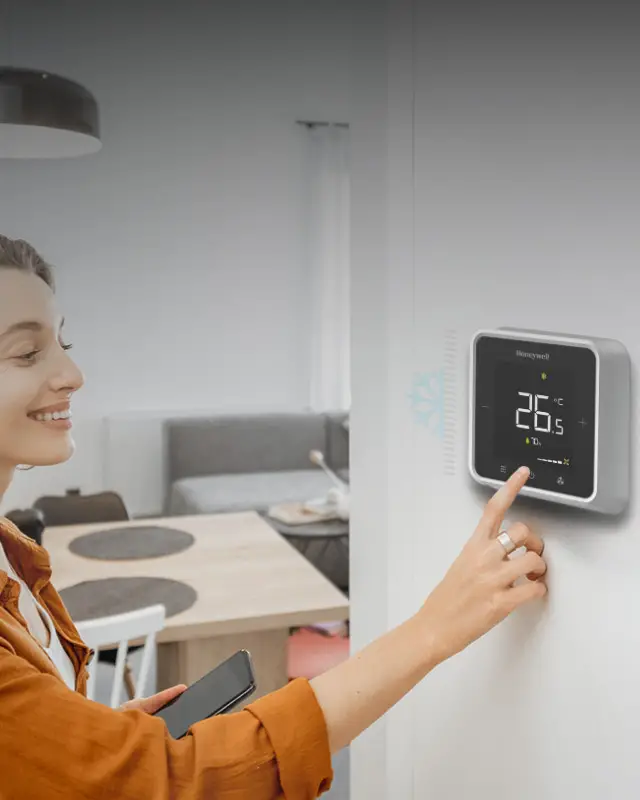Check Best Thermostat Pricing in Amazon
** As an Amazon Associate, I earn from qualifying purchases.
Yes, you can use a Honeywell thermostat on a Trane heat pump. Honeywell thermostats are compatible with various heating and cooling systems, including heat pumps. However, it is crucial to check the compatibility of the specific Honeywell thermostat model with your Trane heat pump to ensure proper functionality and performance.
Understanding Thermostat Compatibility
Before diving into the compatibility between Honeywell thermostats and Trane heat pumps, it’s essential to have a basic understanding of thermostat wiring and the role each wire plays in controlling your HVAC system.
Thermostats typically use a set of wires to connect to various terminals on the HVAC system, enabling control over heating, cooling, and fan functions. However, it’s important to note that there is no standardized color-coding for these wires. Each wire should be identified based on the terminal it connects to, rather than relying on color alone.
To determine if a Honeywell thermostat is compatible with your Trane heat pump, it’s crucial to consult the wiring diagram provided by both manufacturers. Trane’s wiring diagram specifies connections for terminals such as R, Y, O, G, W, x2, B, T, and F. On the other hand, Honeywell thermostats may have different terminal labels, such as B/O, W1, G, Y, O/B, and C. By cross-referencing the wiring diagrams and terminals, you can ensure proper compatibility between the two systems.
Step-by-Step Installation Guide
Now that you have a basic understanding of thermostat compatibility, let’s dive into the step-by-step installation process for connecting a Honeywell thermostat to your Trane heat pump system.
Before proceeding with the installation, it’s crucial to turn off the power at the breaker box or switch that controls your heating and cooling system. Once you have confirmed that the power is off, you can begin the installation process.
Step 1: Remove the Existing Thermostat
Start by removing the existing thermostat from the wall plate. Most thermostats can be easily pulled off the wall, but some may require lifting from the bottom or levering off. Take a picture of the wiring configuration of the existing thermostat, ensuring that the terminal markings are visible. This picture will serve as a reference during the installation process.
Step 2: Review the Existing Wiring Configuration
Review the picture you took of the existing thermostat wiring and compare it to the new Honeywell thermostat’s terminal labels. Make note of any wires not connected to a terminal and do not label these wires. It’s essential to ensure that the wires are correctly identified based on their corresponding terminals.
Check Best Thermostat Pricing in Amazon
** As an Amazon Associate, I earn from qualifying purchases.
Step 3: Disconnect and Label Each Wire
Carefully disconnect each wire from the existing thermostat and label them according to their corresponding terminals. If a terminal has multiple designations, such as W and O/B, make sure to label the wire accordingly. It’s crucial to accurately label each wire to ensure proper installation of the new thermostat.
Step 4: Remove the Old Thermostat Wall Plate and Install the New Wall Plate
After disconnecting and labeling all wires, unscrew the old thermostat wall plate and mount the new thermostat’s wall plate. Ensure that the new wall plate is securely fastened to the wall, as it will support the new thermostat.
Step 5: Connect the Wiring to the New Thermostat
Reconnect the wiring to the new thermostat’s wall plate based on the labeled wires. Follow the terminal labels on the Honeywell thermostat and connect each wire to its corresponding terminal. If the Honeywell thermostat has a terminal designation that matches multiple wires, refer to the picture you took during the earlier step to determine the correct connection.
Step 6: Power on the System and Test
Once all the wiring connections are made, you can turn on the power at the breaker box or switch to activate your Trane heat pump system. Set the thermostat to your desired temperature and ensure that the heating and cooling functions work correctly. It’s essential to test the system thoroughly to verify that the thermostat is properly controlling your HVAC system.
Troubleshooting and Additional Tips
While the installation process outlined above should work for most scenarios, it’s essential to troubleshoot any issues that may arise during the installation or afterwards. Here are a few troubleshooting tips and additional considerations to keep in mind:
- Check for Compatibility: Before purchasing a Honeywell thermostat, ensure that it is compatible with your specific Trane heat pump model. Honeywell provides compatibility information for each thermostat model, allowing you to choose the right one for your system.
- Refer to Manuals and Guides: It’s crucial to thoroughly read the manuals and guides provided by both Trane and Honeywell. These resources will provide detailed instructions and wiring diagrams specific to your equipment.
- Consult a Professional: If you are unsure about any aspect of the installation process or encounter difficulties, it’s always recommended to consult a professional HVAC contractor. They have the expertise and knowledge to ensure a proper installation and can troubleshoot any issues that may arise.
- Perform Regular Maintenance: Once the new thermostat is installed, it’s important to perform regular maintenance on your Trane heat pump system. This includes cleaning or replacing air filters, checking for any leaks or obstructions, and scheduling routine maintenance with a professional HVAC technician.
By following these steps and considering these additional tips, you can successfully replace your Trane thermostat with a Honeywell thermostat and enjoy efficient and reliable control over your Trane heat pump system.
Conclusion
In conclusion, it is possible to use a Honeywell thermostat on a Trane heat pump system. However, it’s essential to ensure compatibility between the two systems and properly wire the thermostat based on the provided wiring diagrams. By following the step-by-step installation guide outlined in this article and troubles.
Check Best Thermostat Pricing in Amazon
** As an Amazon Associate, I earn from qualifying purchases.


